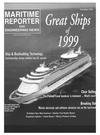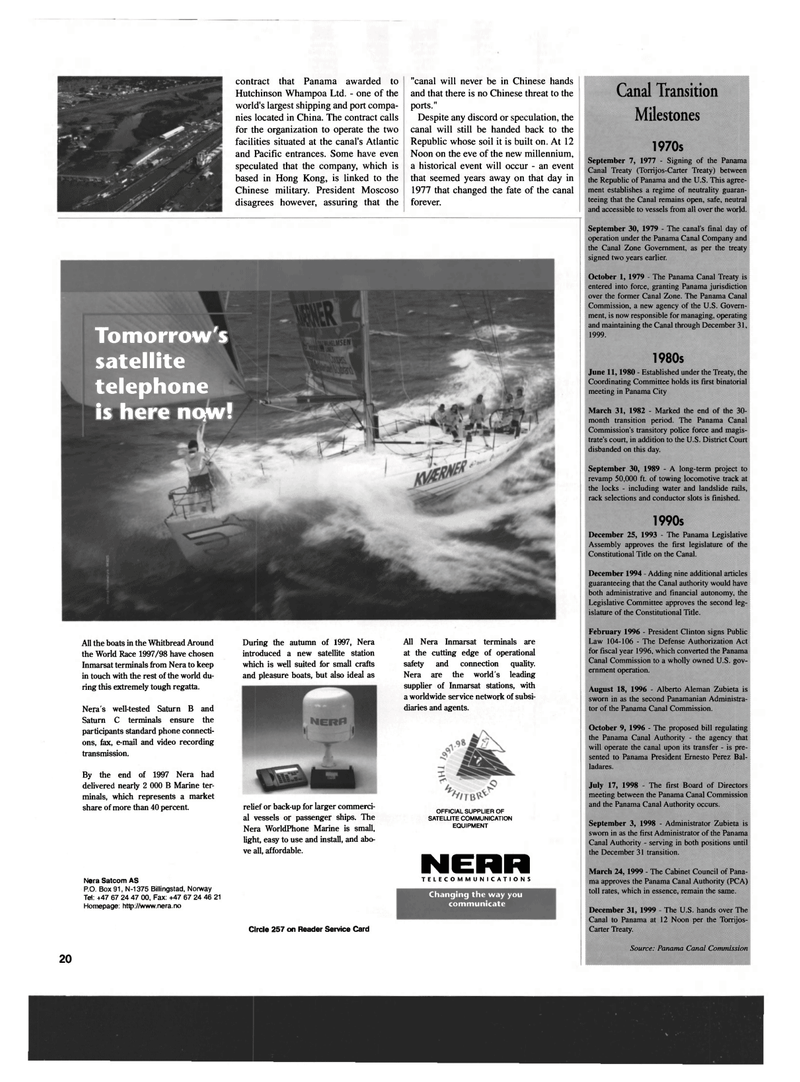
Page 20: of Maritime Reporter Magazine (December 1999)
Read this page in Pdf, Flash or Html5 edition of December 1999 Maritime Reporter Magazine
contract that Panama awarded to
Hutchinson Whampoa Ltd. - one of the world's largest shipping and port compa- nies located in China. The contract calls for the organization to operate the two facilities situated at the canal's Atlantic and Pacific entrances. Some have even speculated that the company, which is based in Hong Kong, is linked to the
Chinese military. President Moscoso disagrees however, assuring that the "canal will never be in Chinese hands and that there is no Chinese threat to the ports."
Despite any discord or speculation, the canal will still be handed back to the
Republic whose soil it is built on. At 12
Noon on the eve of the new millennium, a historical event will occur - an event that seemed years away on that day in 1977 that changed the fate of the canal forever.
All the boats in the Whitbread Around the World Race 1997/98 have chosen
Inmarsat terminals from Nera to keep in touch with the rest of the world du- ring this extremely tough regatta.
Nera's well-tested Saturn B and
Saturn C terminals ensure the participants standard phone connecti- ons, fax, e-mail and video recording transmission.
By the end of 1997 Nera had delivered nearly 2 000 B Marine ter- minals, which represents a market share of more than 40 percent
Nera Satcom AS
P.O. Box 91, N-1375 Biliingstad, Norway
Tel: +47 67 24 47 00, Fax: +47 67 24 46 21
Homepage: http://www.nera.no
During the autumn of 1997, Nera introduced a new satellite station which is well suited for small crafts and pleasure boats, but also ideal as relief or back-up for larger commerci- al vessels or passenger ships. The
Nera WorldPhone Marine is small, light, easy to use and install, and abo- ve all, affordable.
All Nera Inmarsat terminals are at the cutting edge of operational safety and connection quality.
Nera are the world's leading supplier of Inmarsat stations, with a worldwide service network of subsi- diaries and agents.
OFFICIAL SUPPLIER OF
SATELLITE COMMUNICATION
EQUIPMENT
NERR
TELECOMMUNICATIONS
Circle 257 on Reader Service Card 20
Changing the way you communicate
Canal Transition
Milestones 1970s
September 7, 1977 - Signing of the Panama
Canal Treaty (Torrijos-Carter Treaty) between the Republic of Panama and the U.S. This agree- ment establishes a regime of neutrality guaran- teeing that the Canal remains open, safe, neutral and accessible to vessels from all over the world.
September 30, 1979 - The canal's final day of operation under the Panama Canal Company and the Canal Zone Government, as per the treaty signed two years earlier.
October 1, 1979 - The Panama Canal Treaty is entered into force, granting Panama jurisdiction over the former Canal Zone. The Panama Canal
Commission, a new agency of the U.S. Govern- ment, is now responsible for managing, operating and maintaining the Canal through December 31, 1999. 1980s
June 11,1980 - Established under the Treaty, the
Coordinating Committee holds its first binatorial meeting in Panama City
March 31, 1982 - Marked the end of the 30- month transition period. The Panama Canal
Commission's transitory police force and magis- trate's court, in addition to the U.S. District Court disbanded on this day.
September 30, 1989 - A long-term project to revamp 50,000 ft. of towing locomotive track at the locks - including water and landslide rails, rack selections and conductor slots is finished. 1990s
December 25, 1993 - The Panama Legislative
Assembly approves the first legislature of the
Constitutional Title on the Canal.
December 1994 - Adding nine additional articles guaranteeing that the Canal authority would have both administrative and financial autonomy, the
Legislative Committee approves the second leg- islature of the Constitutional Title.
February 1996 - President Clinton signs Public
Law 104-106 - The Defense Authorization Act for fiscal year 1996, which converted the Panama
Canal Commission to a wholly owned U.S. gov- ernment operation.
August 18, 1996 - Alberto Aleman Zubieta is sworn in as the second Panamanian Administra- tor of the Panama Canal Commission.
October 9, 1996 - The proposed bill regulating the Panama Canal Authority - the agency that will operate the canal upon its transfer - is pre- sented to Panama President Ernesto Perez Bal- ladares.
July 17, 1998 - The first Board of Directors meeting between the Panama Canal Commission and the Panama Canal Authority occurs.
September 3, 1998 - Administrator Zubieta is sworn in as the first Administrator of the Panama
Canal Authority - serving in both positions until the December 31 transition.
March 24, 1999 - The Cabinet Council of Pana- ma approves the Panama Canal Authority (PCA) toll rates, which in essence, remain the same.
December 31, 1999 - The U.S. hands over The
Canal to Panama at 12 Noon per the Torrijos-
Carter Treaty.
Source: Panama Canal Commission
Tomorrow's satellite telephone is here now!

 19
19

 21
21
